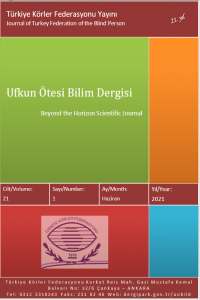KRONİK MEKANİK BEL AĞRILI HASTALARDAKI AĞRI ŞİKAYETİNİN CİNSİYET VE MESLEĞE BAĞLI DEĞİŞKENLİĞİNİN İNCELENMESİ
Amaç: Bu çalışmanın amacı kronik mekanik bel ağrılı hastalarda ağrıbulgularını araştırmaktı. Gereç ve yöntem: Çalışmamız, HacettepeÜniversitesi Sağlık Bilimleri Fakültesi Fizik Tedavi ve RehabilitasyonBölümü Ortopedik Rehabilitasyon Ünitesinde kronik mekanik bel ağrısıtanısı ile başvuran 75 hasta üzerinde retrospektif inceleme ilegerçekleştirildi. Hastaların demografik özellikleri ile birlikte ağrı düzeyleri,istirahat ve aktivite sırasında hissedilen ağrı şiddeti, ağrının lokalizasyonu,ağrının tipi, ilk ağrıyı başlatan olay, ağrının hissedildiği pozisyon ve ilacacevap verip vermediği incelendi.Sonuçlar: Hastalarımızın büyük çoğunluğunu kadınlar (% 65) ve evhanımlarının (% 31) oluşturduğu görüldü. En fazla ağrıyı başlatan olay ağırkaldırma (%69), ağrının hissedildiği pozisyon ayakta uzun süre durma(%52) olarak belirlendi. Ağrı devamlı-künt (%27) ve gerilme tarzında (%27),en fazla bel bölgesinde (%56) tariflendi. Hastaların büyük çoğunluğunun(%77) ağrı kesici ilaç kullanmadıkları belirlendi
Anahtar Kelimeler:
Bel ağrısı, risk grupları, fonksiyonel yetersizlik
INVESTIGATING THE VARIABILITY OF PAIN IN PATIENT WITH CHRONIC LOW BACK PAIN ACCORDING TO SEX AND OCCUPATION
Purpose: The purpose of this study was to investigated pain characteristicsin patients with chronic low back pain.Material-Methods: 75 patients with chronic low back pain wereinvestigated retrospectively in Hacettepe University, Faculty of HealthScience, Department of Physical Therapy and Rehabilitation. The patient’sdemographic information, severity of pain, during physical activity and rest,the region of pain, the type of pain, activity initialising pain, the positionspain is felt the most and response to pain killers.Results: It was seen that most of our patients were women (65%) andhousewives (31%). The activity initialising pain the most lifting weight (69%)the position pain was felt the most was standing for a long while (52%).Pain was noted to be blunt and frequent (27%) and tension mostly locatedat the back. Most of the patients weren’t using pain killers.Discussion: This study indicates that housewives are at great risk inhaving back pain. It is important that ergonomic training should be taughtduring activities that involve lifting weight in preventing low back injuries
Keywords:
Back pain, risk groups, functional insufficient,
___
- WHO. The World Health Report: Reducing risks, promoting healthy life. World Health Organization, Geneva, 2002.
- Çeliker R. Chronic pain syndromes. Turkish Journal of Physical Medicine and Rehabilitation. 2005; 51(Supl. B):B14-B18.
- Turk DC, Okifuji A. Pain terms and taxonomies of pain. In: Loeser JD, eds. Bonica’s: Management of Pain. Philadelphia: Lippincott Williams & Wilkins; 2001: 17-25.
- Seres JL. Evaluating the complex chronic pain patients. Neurosurgery Clinics of North America. 2003; 14:339-562.
- LeResche L. Gender, cultural and environmental aspects of pain. In: Loeser JD, eds. Bonica’s: Management of Pain. Philadelphia: Lippincott Williams&Wilkins; 2001: 191-5.
- Costa LCM, Maher CG, McAuley CH et al. Prognosis for patients with chronic low back pain: inception cohort study. BMC Musculoskeletal Disorders. 2007; 8:1-13.
- Leinonen V, Kankaanpaa M, Airaksinen O et al. Back and hip extensor muscle function during therapeutic exercises. Archives of Physical Medicine and Rehabilitation. 2000; 80: 842-850.
- Liebenson C. Spinal Therapeutics Based on Responses to Loading. In: Butler JP, eds. Rehabilitation of the Spine. Pennsylvania: Williams and Wilkins; 1996: 225-252.
- Malliou P, Gioftsidou A, Beneka A, et al. Measurements and evaluations in low back pain patients. Scandinavian Journal of Medicine &Science in Sports. 2005; 16: 219-230.
- Tulner MV, Koes B, Bombardier C. Low back pain. Best Practice &Research Clinical Rheumatology.2002; 16(5): 761-775.
- Thomas NWM. Low back pain, sciatica, cervical and lumbar spondylosis. Neurosurgery. 2004; 15: 25-28.
- O’Sullivan PB. Lumbar segmental ‘instability’: clinical presentation and specific stabilizing exercise management. Manual Therapy. 2000; 5(1): 2-12.
- Poiraudeau S, Revel M. Rehabilitation therapy in chronic low back pain. Joint Bone Spine. 2000; 67: 582-587.
- Descarreaux M, Normand MC, Laurencelle L, et al. Evaluation of a specific home exercise program for low back pain. Journal of Manipulative and Physiological Therapeutics. 2001; 25(8): 467-503.
- Niemistö L, Lahtinen-Suopanki T, Rissanen P, et al. A randomized trial of combined manipulation, stabilizing exercises, and physician consultation alone for chronic low back pain. Spine. 2003; 28(19): 2185-2119.
- Rainville J, Hartigan C, Martines E, et al. Exercise as a treatment for chronic low back pain. Spine. 2004; 4: 106-115.
- Mıyamoto M, Konno S, Gembun Y, et al. Original Article Epidemiological Study of Low Back Pain and Occupational Risk Factors among Taxi Drivers. Industrial Health. 2008; 46: 112–117.
- Slade SC, Keating JL. Trunk-strengthening exercises for chronic low back pain: a systematic review. Journal of Manipulative and Physiological Therapeutics. 2006; 29(2):163-173.
- Skovron ML. Epidemiology of low back pain. Bailliere s Clinical Rheumatology. 1992; 6(3):559-573.
- Porter SC, Hanley EN. The musculoskeletal effects of smoking. Journal of American Academy of Orthopedic Surgery. 2001; 9(1):9-17.
- Bakırcın N, Torun SD, Sülkü M, Alptekin K. İstanbul’da üç tekstil fabrikasında çalışan işçilerde mekanik bel ağrısı. Toplum Hekimliği Bülteni. ; 26(2). Altınel L, Köse KÇ, Altınel EC. Profesyonel hastane çalışanlarında bel ağrısı prevelansı ve bel ağrısını etkileyen faktörler. Tıp Araştırmaları Dergisi. ; 5(3):115-120. Bovenzia M, Ruia F, Negroa C et al. An epidemiological study of low back pain in professional drivers. Journal of Sound and Vibration. 2006; 298: –539.
- Llyod MH, Gauld S. Soutor CA. Epidemiologic study of back pain in miners and office workers. Spine.1986; 11 (2): 136-140.
- Kelaher D. Effects of Trunk Extensor Muscle Fatique on Trunk Proprioception and Biomechanics. Degree of doctor, North Carolina State University, North Carolina. 2006.
- Eker L, Tüzün EH, Daşkapan A et al. Bel ağrılı hastalarda EQ-5D ve SF- ölçekleri arasındaki ilişki. Fizyoterapi Rehabilitasyon. 2007; 18(1): 3-10.
- Ekici G, Cavlak U, Yağcı N et al. Kronik yaygın ağrısı olan kadınlarda ağrı ve yorgunluğa etki eden faktörlerin incelenmesi. Fizyoterapi Rehabilitasyon 2007; 18(2): 118.
- Başlangıç: 2001
- Yayıncı: Körler Federasyonu
Sayıdaki Diğer Makaleler
YAŞLILARDA NOTTİNGHAM SAĞLIK PROFİLİ VE SF-36 SAĞLIK ANKETİ BENZER SONUÇ VERİR Mİ?
Sibel Aksu YILDIRIM, Öznur YILMAZ
KENTSEL PEYZAJDA YAŞLI / ENGELLİ İÇİN BAĞIMSIZ HAREKET OLANAĞI VE EVRENSEL TASARIM KAVRAMI .pdf
Tülay TARSUSLU, Akmer MUTLU, Mintaze Kerem GÜNEL, Ayşe LİVANELİOĞLU
ZİHİNSEL ENGELLİ ÇOCUKLARIN BÜYÜK KAS MOTOR BECERİLERİNİN DESTEKLENMESİ
